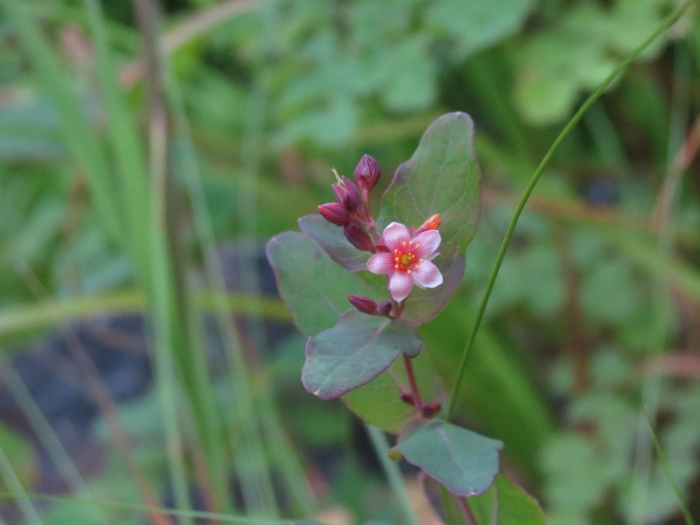Fraser’s Marsh St. Johnswort
(Triadenum fraseri)
Fraser’s Marsh St. Johnswort (Triadenum fraseri)
/
/

Reuven Martin
Public Domain
Image By:
Reuven Martin
Recorded By:
Copyright:
Public Domain
Copyright Notice:
Photo by: Reuven Martin | License Type: Public Domain | License URL: http://creativecommons.org/publicdomain/zero/1.0/ | Rights Holder: Reuven Martin | Publisher: iNaturalist | Date Created: 2016-07-23T18:39:58-07:00 |

















































Estimated Native Range
Summary
Triadenum fraseri, commonly known as Fraser’s Marsh St. Johnswort, is a deciduous perennial herb native to wetland habitats such as bogs, marshes, and wet meadows in the Eastern and Northern USA, as well as parts of Canada. It typically grows to heights of 1 ft (0.30 m) to 2 ft (0.61 m). The plant features blue-green, sometimes purple-tinged, stalkless, elliptical, opposite leaves with prominent, often red stems and veins, which add to its ornamental value. The flowers are pink, five-petaled, with green or purplish sepals, ranging from 0.25 in (0.64 cm) to 0.75 in (1.9 cm) wide when fully open, although they often appear closed like a bud. Each flower has 9 to 12 yellow stamens, and the blooming period extends from July through September.
Fraser’s Marsh St. Johnswort is valued for its unique flowering habit and its ability to thrive in wet conditions, making it suitable for rain gardens, water features, and naturalized wetland plantings. It is also used for its wildlife value, as it provides food for native bees and other pollinators. This plant prefers full sun to part shade and requires medium to high amounts of water, thriving in soils with slow or wet drainage. While it does not have significant disease problems, it can be sensitive to drought and may require additional watering during dry periods. It is not known to be invasive and is generally considered a low-maintenance addition to suitable garden settings.CC BY-SA 4.0
Fraser’s Marsh St. Johnswort is valued for its unique flowering habit and its ability to thrive in wet conditions, making it suitable for rain gardens, water features, and naturalized wetland plantings. It is also used for its wildlife value, as it provides food for native bees and other pollinators. This plant prefers full sun to part shade and requires medium to high amounts of water, thriving in soils with slow or wet drainage. While it does not have significant disease problems, it can be sensitive to drought and may require additional watering during dry periods. It is not known to be invasive and is generally considered a low-maintenance addition to suitable garden settings.CC BY-SA 4.0
Plant Description
- Plant Type: Herb
- Height: 1-2 feet
- Width: 0.5-1.5 feet
- Growth Rate: Moderate
- Flower Color: Pink
- Flowering Season: Summer
- Leaf Retention: Deciduous
Growth Requirements
- Sun: Full Sun, Part Shade
- Water: Medium, High
- Drainage: Slow, Wet
Common Uses
Low Maintenance, Water Garden
Natural Habitat
Wetland habitats such as bogs, marshes, and wet meadows
Other Names
Common Names: Bog St. John’s Wort, Fraser’s St. John’s Wort
Scientific Names: , Triadenum fraseri, Hypericum fraseri, Hypericum virginicum var. fraseri, Triadenum virginicum subsp. fraseri, Elodea fraseri, Elodes fraseri, Triadenum viginicum subsp. fraseri, Triadenum virginicum var. fraseri,
GBIF Accepted Name: Triadenum fraseri (Spach) Gleason